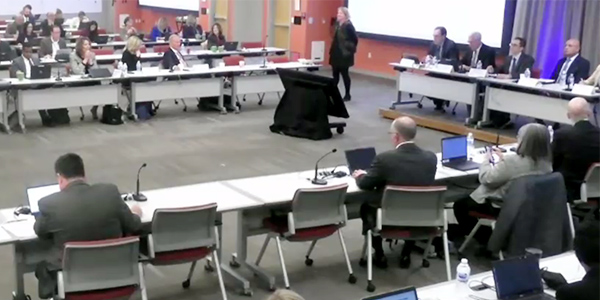By Christen Smith
PJM members endorsed a resolution Thursday that objects to a Tariff attachment pending before FERC that would create a new confidential process to mitigate critical infrastructure on NERC’s CIP-014-2 list.
The unusual step came less than a week after a group of transmission owners submitted the proposal to the commission following several tense conversations dating back to August that left other sectors wary of its vague details.
LS Power, author of the resolution, argues that incumbent TOs don’t get exclusive rights to handling critical infrastructure on the list. Because the projects could carry significant regional implications, the company believes PJM should plan their mitigation — a point other stakeholders echoed during the Members Committee meeting on Thursday. (See PJM TO Filing Stirs Up Transparency Concerns.)
“We feel strongly that PJM should have stepped up and taken this issue under its wing as a reliability issue,” said Carl Johnson of the PJM Public Power Coalition. “It would have saved us a lot of trouble.”
The resolution alleges that the filing also conflicts with the Operating Agreement because mitigating these critical assets — which count as a subset of supplemental projects — must involve an open and transparent discussion with stakeholders. But doing so, the TOs contend, poses the dilemma that the highly secretive location of these facilities could be revealed. (See “Critical Infrastructure Resolution,” PJM MRC/MC Briefs: Dec. 5, 2019.)
The TOs also point out that NERC’s confidentiality standards — and their rights under PJM’s Attachment M-4 process — support their intention to file the mitigation plan at FERC without consent from other sectors.
In an effort to quell rising concerns, TOs collected questions from other stakeholders and hosted a webinar in November to answer some of them publicly. The two-hour meeting, however, left many issues unresolved. Seemingly frustrated by the unfolding process, the Planning Committee endorsed an issue charge in December to consider whether PJM must develop governing document language to deal with the mitigation of existing and future critical infrastructure on the list. (See “Critical Infrastructure Mitigation,” PJM PC/TEAC Briefs: Dec. 12, 2019.)
Top-secret Cost
PJM has refused to take sides in the debate, despite protests from stakeholders that mitigating the facilities presents risks to reliability that the RTO should handle. It’s a decision staff now question, Vice President of Planning Ken Seiler said. (See PJM Remains Neutral in CIP-014 Debate.)
“I agree, we could have done things differently,” he said, noting that a rough estimate of the cost to remove these assets from the list would total much less than $1 billion.
When stakeholders pressed for a more accurate cost estimate — key information many said may make them more comfortable with the Tariff filing — Seiler declined.
“We’ve looked at what the potential solutions would be and most of them are fairly simple,” he said. “Line rerouting, substation reconfiguration, very minor things that would keep the cost at a reduced rate for everybody … we are nowhere near into the billions of dollars on this.”
Sharon Segner, vice president of LS Power, said that although Seiler’s feedback was “encouraging,” there’s nothing in the Tariff proposal that caps costs.
“What would encourage my company even more would be for PJM to be in charge of these top-secret projects,” she said. “If PJM were to be in charge, then this language would go in the OA and not the Tariff. If it’s in the Tariff, at the end of the day, the TOs are in charge. There’s nothing in this language that provides cost containment. There’s a finite number of projects, but there is no restriction on cost.”
PJM Board of Managers member Susan Riley — who last month encouraged TOs and PJM to tally a cost for projects on the list — pushed back against sentiments that the RTO should have greater authority over the process.
“We’ve agreed to have an oversight role,” she said. “TOs have ultimate authority. I know the costs have been moving around, but they are moving down. We are reasonably confident that it won’t be more than $1 billion and won’t be more than 20 projects. We are committed in a very public way. Whether or not there wasn’t enough discussion, that’s up to you. I think there was.”
The MC endorsed the resolution in a sector-weighted vote of 3.83 to 1.17. Segner said LS Power intends to submit the resolution as part of its protest against the TO proposal. Comments on the filing are due within 21 days, Segner said, hence the timing of the vote.






